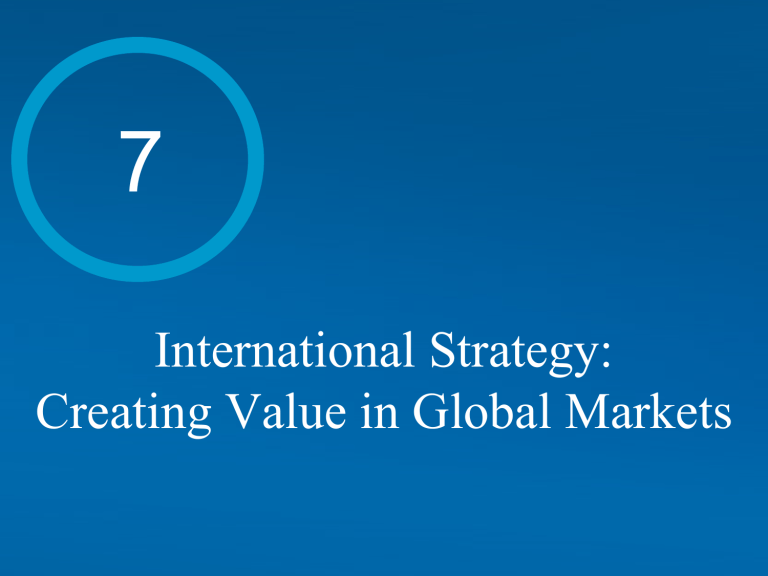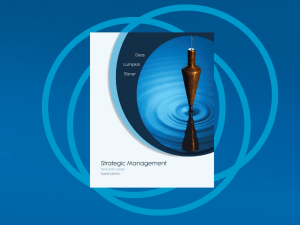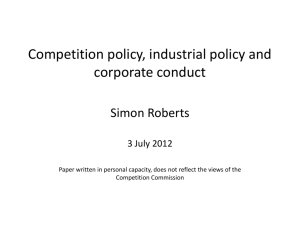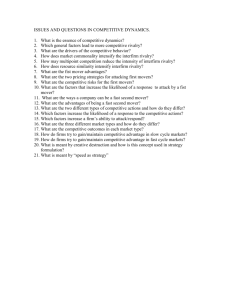
7 International Strategy: Creating Value in Global Markets 7-2 Factors Affecting a Nation’s Competitiveness • Factor conditions - Nation’s position in factors of production • Skilled labor • Infrastructure • Demand conditions - Nature of home-market demand • Industry’s product • Industry’s service 7-3 Factors Affecting a Nation’s Competitiveness • Related and supporting industries - Presence or absence in the nation of internationally competitive • Supplier industries • Other related industries • Firm strategy, structure, and rivalry - Conditions in the nation governing how companies are • Created • Organized • Managed - Nature of domestic rivalry 7-4 Factor Conditions • To achieve competitive advantage, factors of production must be created - Industry specific - Firm specific - Pool of resources at a firm’s or country’s disposal is less important than the speed and efficiency with which the resources are deployed 7-5 Demand Conditions • Demands that consumers place on an industry for goods and services - Demanding consumers push firms to move ahead of companies from other nations - Demanding consumers drive firms in a country to • Meet high standards • Upgrade existing products and services • Create innovative products and services 7-6 Related and Supporting Industries • Related and supporting industries - Enable firms to manage inputs more effectively - Strong supplier base adds efficiency to downstream activities - Competitive supplier base lets a firm obtain inputs using cost-effective, timely methods - Allow joint efforts among firms - Create the probability that new entrants will enter the market 7-7 Firm Strategy, Structure and Rivalry • Rivalry is intense in nations with conditions of - Strong consumer demand - Strong supplier bases - High new entrant potential from related industries • Competitive rivalry increases the efficiency with which firms develop, market, and distribute products and services within the home country 7-8 Firm Strategy, Structure and Rivalry • Competitive rivalry increases the efficiency with which firms - Develop within the home country - Market within the home country - Distribute products and services within the home country 7-9 Firm Strategy, Structure and Rivalry • Domestic rivalry provides a strong impetus for firms to - Innovate - Find new sources of competitive advantage • Domestic rivalry forces firms to look beyond national borders for new markets 7 - 10 Porter’s Diamond of National Advantage: As Applied to India Adapted from Exhibit 7.1 India’s Diamond in Software 7 - 11 A Company’s Motivation for International Expansion • Increase the size of potential markets • Attain economies of scale • Reducing the costs of R&D as well as operating costs • Extend the life cycle of a product • Optimize the physical location for every activity in its value chain - Performance enhancement - Cost reduction - Risk reduction 7 - 12 Potential Risks of International Expansion • Political and economic risk - Social unrest Military turmoil Demonstrations Violent conflicts and terrorism Laws and their enforcement 7 - 13 Risk Rankings 7 - 14 Potential Risks of International Expansion • Currency risks - Currency exchange fluctuations - Appreciation of the U.S. dollar • Management risks - Culture Customs Language Income levels Customer preferences Distribution system 7 - 15 Outsourcing and Offshoring • Outsourcing occurs when a firm decides to utilize other firms to perform value-creating activities that were previously performed in-house. • Offshoring takes place when a firm decides to shift an activity that they were previously performing in a domestic location to a foreign location. 7 - 16 Opposing Pressures and Four Strategies Exhibit 7.4 Opposing Pressures and Four Strategies 7 - 17 International Strategy • Pressure for both local adaptation and low costs are rather low • Different activities in the value chain have different optimal locations • Susceptible to higher levels of currency and political risks 7 - 18 Global Strategy • Competitive strategy is centralized and controlled largely by corporate office • Emphasizes economies of scale • Advantages - Larger production plants Efficient logistics and distribution networks Supports high levels of investment in R&D Standard level of quality throughout the world 7 - 19 Global Strategy • Disadvantages - Concentration on scale-sensitive resources and activities in one or few locations leads to higher transportation and tariff costs - Activity is isolated from targeted markets - The rest of the firm becomes dependent on that geographically isolated location 7 - 20 Multidomestic Strategy • Emphasis is differentiating products and services to adapt to local markets • Authority is more decentralized • Risks include - Increased cost structure - Potential problems with local adaptations - Finding optimal degree of local adaptation is difficult 7 - 21 Transnational Strategy • Optimization of tradeoffs associated with efficiency, local adaptation, and learning • Firm’s assets and capabilities are dispersed according to the most beneficial location for a specific activity • Avoids the tendency to either - Concentrate activities in a central location - Disperse them across many locations to enhance adaptation 7 - 22 Transnational Strategy • Unique risks and challenges - Choice of an “optimal” location cannot guarantee that the quality and cost of factor inputs will be optimal - Knowledge transfer can be a key source of competitive advantage, but it does not take place automatically 7 - 23 Entry Modes of International Expansion 7 - 24 Thank You
![Lecture 2a How to Th.. - of [www.mdavis.cox.smu.edu]](http://s3.studylib.net/store/data/008571683_1-b9817424524385f28bc5c351abe2212a-300x300.png)




